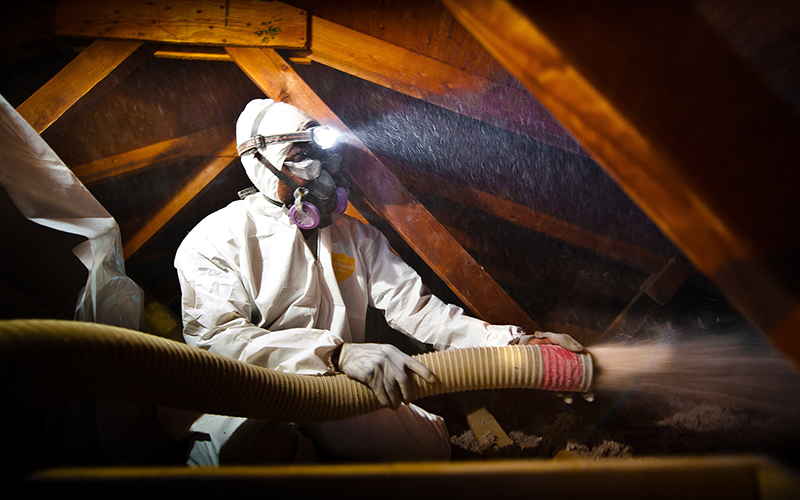
A worker blows cellulose insulation in the attic of a home as part of the federal government’s Weatherization Assistance Program, which improves energy efficiency of low-income homes. (Photo by Dennis Schroeder/ energy.gov)

Brian Bernal installs a carbon monoxide detector during an energy audit of a Colorado home as part of a government weatherization program. (Photo by Dennis Schroeder/energy.gov)
WASHINGTON – Arizona got more than $21 million to help low-income residents pay their heating bills last year and another $1 million for home weatherization – money that would be lost under the Trump administration’s proposed budget.
President Donald Trump’s fiscal 2018 budget would eliminate the Low-Income Home Energy Assistance Program and the Weatherization Assistance Program, programs that the administration said do not perform as well as they should and which are better handled at the state level.
The programs are relatively small in terms of federal spending – LIHEAP nationally cost $3.36 billion in fiscal 2016 – but advocates say they make a big difference for low-income families who receive the funding, allowing them to stretch their household budgets so they don’t have to make a “heat or eat” decision.
“When you are living in a home that’s not well insulated, your energy bill can be very expensive, and what LIHEAP does is allow for assistance so people can afford to feed their families,” said Mark Hall, executive director of Red Feather development group, which works with partners in the Hopi and Navajo reservations on sustainable housing.
“If that (funding) gets cut and their bill goes from $30 to $300 a month, that is significant,” Hall said.
But small-government groups welcomed the cuts, calling the programs another example of one-size-fits-all policy imposed on the states by the federal government. Cutting the federal programs will allow states to set their own priorities for weatherization and low-income heating assistance programs, they said.
“It really provides an opportunity to devolve responsibility down to the states that should be left to the states,” said Nick Loris, a Heritage Foundation fellow in environmental and energy policy.
“I think they (the states) have a good track record of maintaining and promoting public health and safety,” Loris said.
The federal LIHEAP program is used to help low-income families pay their heating and cooling bills, while the weatherization program is used to make homes more energy efficient and protect occupants from the impacts of exposure.
Private groups also have a role in funding the programs, in addition to the government. In Arizona, utilities such as Salt River Project and Arizona Public Service contribute to the programs.
SRP provides $725,000 per year to the Arizona Community Action Association to help low-income homeowners, in addition to federal funding that the state receives for weatherization.
Yolanda France, SRP director of customer contact operations, said the utility’s contribution provides a cushion for providers so they can “avoid a situation where people are turned away because the needs exceed the federal dollar limit per home.”
Still, France said, LIHEAP accounts for 68 percent of all bill assistance received by SRP customers. She said around 9,700 SRP customers got LIHEAP assistance for 2016. SRP offers a variety of assistance programs to customers but France said “it is doubtful these options would make up the difference if LIHEAP were eliminated.”
Cynthia Zwick, executive director at the community action association, said current funding is not enough to address the need as is. Even with federal funding, she said the two programs are only serving “the tip of the iceberg of the need.”
“From our perspective, it would be devastating to lose funding for this program,” Zwick said. “It is not a program that someone can reasonably suggest is ineffective. We are grateful and it really does help us reach more households than we would otherwise be able to reach, so pulling it will be devastating.”
Hall said the cuts would hit Native Americans particularly hard. He said weatherization is critical in Indian Country as it helps upgrade older homes that typically have poor insulation.
“The concern I have is that a lot of the low-income people we’re serving in Indian Country are on some sort of energy bill assistance program that LIHEAP offers,” Hall said.
Zwick said low-income households that are not weatherized spend up to 30 percent of their annual income on energy bills compared to about 5 percent for those that are weatherized.
Not only do the programs help low-income households, they are also essential to helping the environment by reducing energy use, she said.
“This program reduces the drain on the grid and it reduces the kilowatt hours folks need to use and therefore pay for,” Zwick said. “Any money saved on utilities can then be used to support family needs in other areas. No one wants to pay too much for energy.”